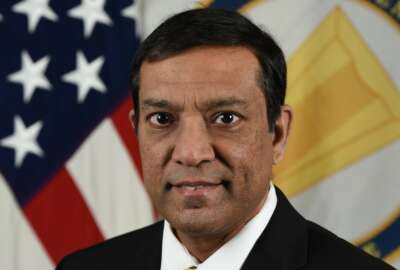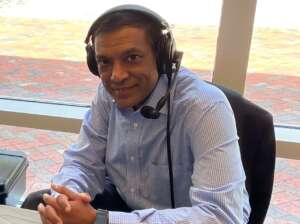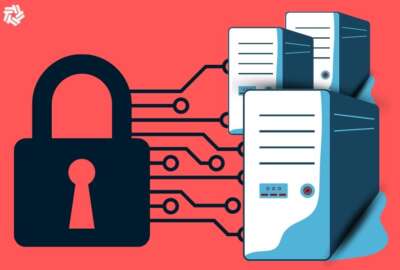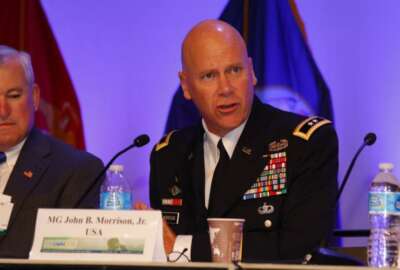
As Iyer exits, Army CIO’s office holds more influence, authority than ever
Raj Iyer’s last day as the Army’s chief information officer is Feb. 10, after which he plans to return to industry but continue to support the service’s...
Raj Iyer’s legacy as the Army’s chief information officer will include major changes across the service down to how the warfighter accesses and uses technology.
The one transformation that may get lost in history sometime in the next five or 10 years may be his most important change.
Iyer, whose last day as Army CIO is Feb. 10 after more than two years on the job, gave the Army CIO a bigger seat at the funding table when it comes to decisions and oversight over technology.

The CIO, along with Gen. John Morrison, the Army’s G6, now are positioned like no previous service technology executives have ever been before to drive enterprise capabilities, standardization and, most importantly, change across the force.
“The Army kept buying the same old, same old, was funding the same old, same old, and quite frankly, the CIO was not in a position to really influence or change any of that. So for the budget cycle that starts 2025, the CIO with the G6 as the co-chairman, now has what’s called the Digital Requirements and Resourcing Construct (DRRC),” Iyer said in an “exit” interview on Ask the CIO. “What the Army has done this year is we’ve moved about $5 billion of the $16 billion budget under this new construct, where the CIO now gets to prioritize the requirements. We do the racking and stacking of the priorities, and then we decide, based upon urgent requirements and future modernization efforts, how we need to rebalance the portfolio.”
This new perspective for the CIO’s office and the G6 isn’t just focused on spending, but where there opportunities to address duplication that will reduce spending.
“We are economists in terms of the decision making, obviously, all decisions the end of the day for budgeting go up to the Secretary and the Chief of Staff of the Army to make, but right now with this new framework, we have technical experts on my team, financial management experts on my team along with my counterpart Gen. Morrison and his team, actually making these decisions and tradeoffs, and it’s a far, far more effective process than the Army’s ever known before,” Iyer said. “The way the Army has always budgeted for IT is it had to compete with all kinds of other priorities in the Army. We have other buckets, where the Army’s budget goes into one for manning the Army, one is for equipping the Army, one is for sustaining the Army and one for Army readiness. We always had to compete against each one of those priorities. And as you can imagine, it has not worked well for us as we’re always competing against something that was a higher priority.”
Iyer said this led to duplication of IT spending across programs because of the heavily decentralized nature of the program evaluation groups. In turn, the CIO’s ability to influence and advise those decisions was limited.
First permanent civilian CIO
This challenge is not uncommon across the federal government. Starting with the Clinger-Cohen Act in 1996 and leading up to the Federal IT Acquisition Reform Act (FITARA) and in between several memos from the Office of Management and Budget, lawmakers, along with Democrat and Republican administrations, have tried to empower agency CIOs over the last 20 years.
Unlike the other services, the Army’s CIO has typically been a high ranking officer and combined with the G6 duties.
In August 2020, the Army split the CIO from the G6 and Iyer stepped into the CIO’s role as the first permanent civilian to take the lead.
In 2018, both the Air Force and the Navy restructured their respective CIO offices. The Navy got rid of the Department of Navy CIO office and gave the title to the undersecretary of the Navy. The Air Force followed a similar path a few months later adding the formal title to the undersecretary. The Navy switched back in 2019 naming and giving the DON CIO wider discretion around IT and cyber governance.
Iyer said when he took the two-year term limited contract he set specific goals to modernize Army processes and infrastructure. He outlined these goals in the Army’s Digital Transformation Strategy released in October 2021.
Iyer said the budget transformation came from part of meeting the goals under the three pillars of modernization and readiness, reform, and people and partnerships.
“It starts with really looking at the big changes that we’ve already made over the last two years. The cloud is one perfect example. The rate at which we’ve implemented cloud across the Army has now led us to really rethink some of the existing programs for which we had requirements five years ago,” he said. “One really simple example is we know that we’re under a mandate to migrate to Windows 11 across the Army. And yet, what we’ve done just in the last six months is we’ve established a virtual desktop infrastructure in the cloud that’s now pushing out Windows 11 to every device that’s either a government furnished equipment or even a personal laptop. It doesn’t matter. So cloud has really accelerated our efforts to get to Windows 11. If we were doing it the old way, which was the Army budgeting for Windows 11 and implementation, it would have meant that the Army would have to buy a large number of new laptops to support the new hardware requirements that comes from Windows 11.”
Network portfolio is first
Iyer said now the Army can be more agile in how it applies technology and funding, and take advantage of greater centralization of capabilities.
In preparation for the 2025 budget when the CIO and G6 has full control over IT, Iyer said his office is starting with the network subportfolio, which includes the network, satellite communications, data centers, cloud services and associated circuits and licenses.
“My intent and hope is that when we do this well, next year, we will start to add other parts of the subportfolio under this new construct: things like business systems and then some of the larger acquisition programs, like tactical radios,” he said. “That’s how we will slowly scale up and ramp up to the full portfolio. But we’re going this year after the part of the portfolio that requires the greatest help right now, and especially because of so much progress we have made with the unified network and cloud, that was important for us to rebalance our portfolio.”
Another area Iyer said he is both proud of the Army’s accomplishments and is what’s on tap for the next CIO is the move toward a zero trust architecture.
He said the Army recently put in place a ZTA strategy and implementation program called Knights Watch.
“We established a functional management office at Army Cyber Command to lead the zero trust program. We have aligned all of the funding and resources to make sure that they’re all kind of pulling together to meet that unified integrated effort,” Iyer said. “Now, the key challenge for the Army is zero trust is a very, very different approach to cybersecurity protection than the network defense approach in the past. This is a big culture change for folks that have to now look at how they need to protect the data. It’s not just about protecting the network, which we have done very well in the past. But this is now pivoting to data-centricity and how we protect the crown jewels. Everybody now has a role to play in the enterprise. When it comes to theater cross-system owners have to now tag data. They have to now establish the business rules and the policies around who gets access to what data and under what conditions. We have to set the business rules around how we’re going to integrate real time threat intelligence. How and when we stop access to data to somebody, and what the operational impacts might be, if they can’t access data, because of the environment or the cybersecurity landscape.”
As for Iyer, he said he will return to industry, likely with a Silicon Valley company focusing on the product side. But he said he plans to stay connected with the Army and see how those changes he initiated continue to take hold and improve the warfighters’ ability to meet mission goals.
Copyright © 2024 Federal News Network. All rights reserved. This website is not intended for users located within the European Economic Area.
Jason Miller is executive editor of Federal News Network and directs news coverage on the people, policy and programs of the federal government.
Follow @jmillerWFED






